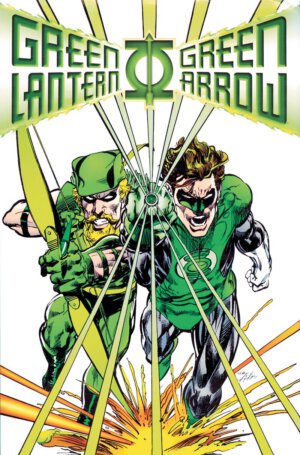
Publisher: DC Comics
Writers: Elliot Maggin and Dennis O’Neil
Artists: Bernie Wrightson, Dick Giordano, and Neal Adams
Publication Date: August, 2012
Pages: 368 pages
Format: Full color softcover
Retail Price: $29.99
Genre: Classic superhero team up
The trailblazing GREEN LANTERN/GREEN ARROW epics from the start of the 1970s are collected in a single paperback edition for the first time! • Spotlights the art of NEAL ADAMS in stories that tackled the greatest social issues of the day! • Collecting GREEN LANTERN #76-87 and 89, and stories from THE FLASH #217-219 and 226.
***
In the spirit of St Patrick’s Day this Monday, TGG has decided to show a little green! Well, not exactly… But maybe some green by way of DC Comics’ Green Lantern and Green Arrow. Legendary artist Neal Adams and writer Dennis “Danny” O’Neil teamed up to tackle the emerald duo in the 1970s for a crossover series which took place in an evolving period of comic history. This collection contains some of the true classics which helped DC Comics maintain their rank alongside Marvel, as well as brought a jolt of life to two heroes who were struggling with sales on comic book stands back in the day. Instead of diving to each story individually, let me tell you exactly that this series meant to the future of the characters and the comic world in general.
Previous to this series Green Arrow was always playing second fiddle in other hero’s comic books, bouncing around as a ‘special guest appearance’ since he was never really recognized as not a prominent hero and never really struck a chord with anyone. It was not until Neal Adams did a complete visual overhaul on Green Arrow/Oliver Queen (which gave him a new look and swagger) that people took notice. The revision was a success and Green Arrow ended up becoming a complimentary co-star to Green Lantern. To best describe the change, if Batman and Robin Hood were to have baby he would be called Green Arrow. I know disturbing right? In all honesty, if Neal’s reboot never happened, EW’s hit show ‘Arrow’ would be non-existent. So for fans of the show, I’d say a big ‘Thank you Neal!’ is certainly in order.
Save Green Lantern!
Before this series took place, Green Lantern was a hard ticket to sell. The character was seriously on its last legs and slated for cancellation. Yet when teamed up with Green Arrow, writer O’Neil was allowed to utilize his creative freedom and show a side of Hal Jordan that readers never saw before. When combating their foes, Lantern and Arrow were a team but off and on their differences or ‘pet-peeves’ would cause conflicts between the two. The pairing ended up becoming a good twist to the stories and gave the readers more sense of definition and dominance, which was the soul principle for bringing the two characters together in the first place, especially with Green Lantern/Hal Jordan. Originally there was a story and origin in Green Lantern comics but nothing that really gave him a personality or let him stand out from the norm. The relationship of the two heroes was just the right mixture to draw enough interest and Green Lantern was here to stay!
Challenging the Authority!
And Legends were born!
Not only did this series bring together two heroes but two would be legends as well in the form of O’Neil/Adams. Before the Green Arrow/Lantern series, they had worked together with Marvel Comics where they not only saved the X-men but revived one of the most well-known characters in Professor X. The revisionary trend didn’t stop there as they also they steered Batman into a darker look and feel; far removed from the “Bang” and “Pow!” of the 1960s TV shows. With Green Lantern/Green Arrow, O’Neil and Adams went on to win multiple awards which included Best Individual Story for “No Evil Shall Escape My Sight” (Issue: #76), Best Pencil Artist and Best Individual Story for “Snowbirds Don’t Fly” (Issue: #85).
I am not going to lie, if you are a younger generation and into the new style comics with new slang and digital art, these comics may be difficult for you to get into. Which really is my only negative. The social events that was pushed into stories would be hard to relate, unless you are from or have a grasp of the 70’s time frame. Artistically it may seem too ‘cartoony’ and dull for some as well.
In the end, the series itself was not a big seller which DC had hoped for and was cancelled in 1972 ending with issue #89. However, the series proved enough that it was pivotal moment for the future of the characters and comics. As far as this collection is concerned, I recommend this set to any of those who love the raw original comic form. If you read comics in the 70’s or 80’s and yearn for down to earth classics, with a thirst for history, this is your ticket. If you’re a fan of the individual characters then this is must have.